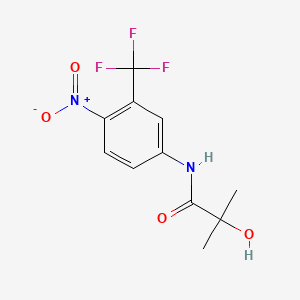Drug Information
Drug (ID: DG00981) and It's Reported Resistant Information
| Name |
Hydroxyflutamide
|
||||
|---|---|---|---|---|---|
| Synonyms |
Hydroxyflutamide; 52806-53-8; 2-hydroxyflutamide; 2-Hydroxy-2-methyl-N-(4-nitro-3-(trifluoromethyl)phenyl)propanamide; Hydroxyniphtholide; hydroxy-flutamide; 2-hydroxy-2-methyl-N-[4-nitro-3-(trifluoromethyl)phenyl]propanamide; Sch 16423; Hydroxy Flutamide; 2-Hydroxy-2-methyl-N-(4-nitro-3-(trifluoromethyl)-phenyl)propanamide; UNII-31D90UKP5Y; CHEMBL491; 31D90UKP5Y; Propanamide, 2-hydroxy-2-methyl-N-[4-nitro-3-(trifluoromethyl)phenyl]-; MFCD00563126; OH-flutamide; DSSTox_CID_13562; DSSTox_RID_79084; DSSTox_GSID_33562; HFT; Hydroxyflutamid; Liproca Depot; Propanamide, 2-hydroxy-2-methyl-N-(4-nitro-3-(trifluoromethyl)phenyl)-; SMR001227196; 2-Hydroxy-flutamide; CAS-52806-53-8; 2-hydroxy Flutamide; 2ax6; .alpha.-hydroxyflutamide; alpha,alpha,alpha-Trifluoro-2-methyl-4'-nitro-m-lactotoluidide; 2-HOF; cid_91649; MLS001061267; MLS006011954; BIDD:ER0519; GTPL2862; SCHEMBL3079778; DTXSID8033562; SCHEMBL19117358; BDBM35909; HMS3039A05; BCP12495; Hydroxyflutamide, >=98% (HPLC); ZINC4655055; Tox21_201204; Tox21_303659; Hydroxyflutamide (Hydroxyniphtholide); AKOS007930906; CS-W013988; HY-W013272; MCULE-6726517919; SB17029; s10360; NCGC00091014-01; NCGC00091014-02; NCGC00091014-03; NCGC00091014-04; NCGC00091014-06; NCGC00257382-01; NCGC00258756-01; BS-17460; A1728; FT-0627147; H1600; X6072; A21118; Q15633976; 2-Hydroxy-4'-nitro-3'-(trifluoromethyl)isobutyranilide; Z1617901126; 2-Hydroxy-2-methyl-N-[4-nitro-3-(trifluoromethyl)phenyl]propionamide; 2-Hydroxy-2-methyl-N-(4-nitro-3-trifluoromethyl-phenyl)-propionamide (hydroxy flutamide); 2-Hydroxy-2-methyl-N-(4-nitro-3-trifluoromethyl-phenyl)-propionamide(Hydroxyflutamide); 2-Hydroxy-2-methyl-N-[4-nitro-3-(trifluoromethyl)phenyl]propanamide (2-Hydroxyflutamide); 2-HYDROXY-2-METHYL-N-(4-NITRO-3-(TRIFLUOROMETHYL)PHENYL)PROPANAMIDE; HYDROXYNIPHTHOLIDE
Click to Show/Hide
|
||||
| Indication |
In total 2 Indication(s)
|
||||
| Structure |

|
||||
| Drug Resistance Disease(s) |
Disease(s) with Clinically Reported Resistance for This Drug
(1 diseases)
[1]
|
||||
| Target | Androgen receptor (AR) | ANDR_HUMAN | [1] | ||
| Click to Show/Hide the Molecular Information and External Link(s) of This Drug | |||||
| Formula |
C11H11F3N2O4
|
||||
| IsoSMILES |
CC(C)(C(=O)NC1=CC(=C(C=C1)[N+](=O)[O-])C(F)(F)F)O
|
||||
| InChI |
1S/C11H11F3N2O4/c1-10(2,18)9(17)15-6-3-4-8(16(19)20)7(5-6)11(12,13)14/h3-5,18H,1-2H3,(H,15,17)
|
||||
| InChIKey |
YPQLFJODEKMJEF-UHFFFAOYSA-N
|
||||
| PubChem CID | |||||
| TTD Drug ID | |||||
Type(s) of Resistant Mechanism of This Drug
Drug Resistance Data Categorized by Their Corresponding Diseases
ICD-02: Benign/in-situ/malignant neoplasm
| Drug Resistance Data Categorized by Their Corresponding Mechanisms | ||||
|
|
||||
| Key Molecule: Androgen receptor (AR) | [1] | |||
| Molecule Alteration | Missense mutation | p.T877A |
||
| Resistant Disease | Prostate cancer [ICD-11: 2C82.0] | |||
| Experimental Note | Identified from the Human Clinical Data | |||
| Experiment for Molecule Alteration |
Energy decomposition assay | |||
| Mechanism Description | However, a drug resistance problem appears after about one year's treatment. AR T877A is the first mutation that was found to cause a resistance problem. Then W741C_T877A and F876L_T877A mutations were also reported to cause resistance to HF, while W741C and F876L single mutations cannot. | |||
| Key Molecule: Androgen receptor (AR) | [1] | |||
| Molecule Alteration | Missense mutation+Missense mutation | p.W741C+T877 |
||
| Resistant Disease | Prostate cancer [ICD-11: 2C82.0] | |||
| Experimental Note | Identified from the Human Clinical Data | |||
| Experiment for Molecule Alteration |
Energy decomposition assay | |||
| Mechanism Description | However, a drug resistance problem appears after about one year's treatment. AR T877A is the first mutation that was found to cause a resistance problem. Then W741C_T877A and F876L_T877A mutations were also reported to cause resistance to HF, while W741C and F876L single mutations cannot. | |||
| Key Molecule: Androgen receptor (AR) | [1] | |||
| Molecule Alteration | Missense mutation+Missense mutation | p.F876L+T877A |
||
| Resistant Disease | Prostate cancer [ICD-11: 2C82.0] | |||
| Experimental Note | Identified from the Human Clinical Data | |||
| Experiment for Molecule Alteration |
Energy decomposition assay | |||
| Mechanism Description | However, a drug resistance problem appears after about one year's treatment. AR T877A is the first mutation that was found to cause a resistance problem. Then W741C_T877A and F876L_T877A mutations were also reported to cause resistance to HF, while W741C and F876L single mutations cannot. | |||
References
If you find any error in data or bug in web service, please kindly report it to Dr. Sun and Dr. Zhang.
